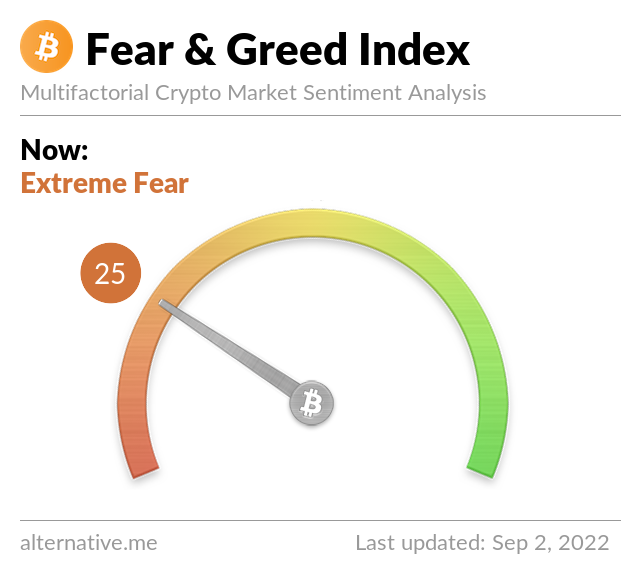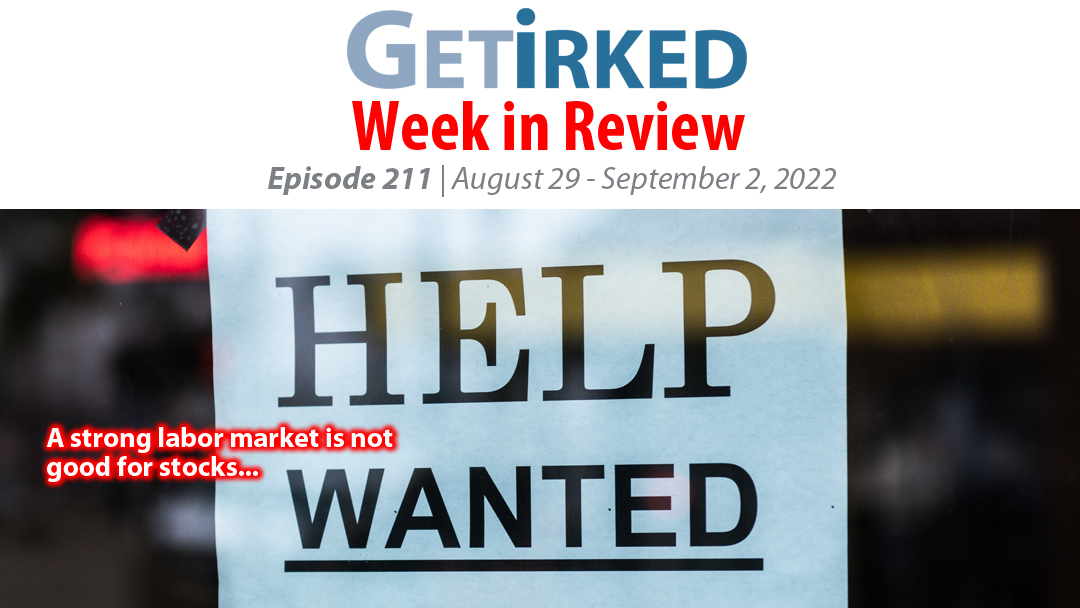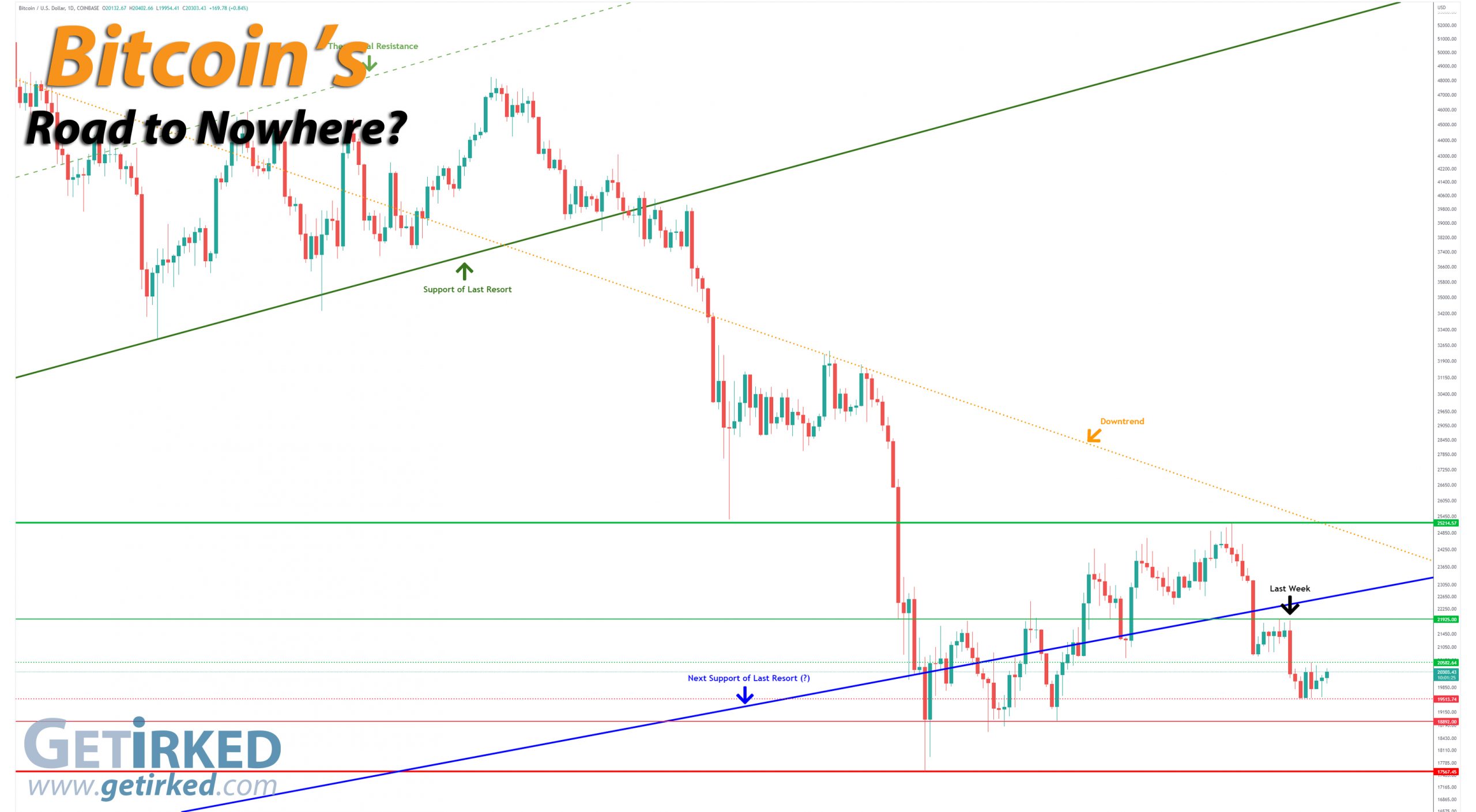Summing Up The Week
The markets were left reeling after Federal Reserve Chairman Jerome Powell’s hawkish speech from Jackson Hole last week. And the news didn’t get any easier this week, either.
Jobs data showed strength and a strong labor market means more tightening from the Fed, and this fact was only exacerbated when Fed President Loretta Mester, normally dovish, said in an interview that she expects a 4% benchmark rate, an interest rate not seen since before the Great Financial Crisis in 2008!
Let’s take a look at the news that moved the markets this week…
Market News
Job openings nearly double available workers
On Tuesday, the Job Openings and Labor Turnover Survey (JOLTS) revealed 11.24 million job openings in July, beating estimates of 10.3 million and nearly double the available worker population, reported CNBC. The market, which had already sold off slightly continuing last week’s rout, continued to drop in earnest following the report as a strong job market implies the Federal Reserve will continue fighting inflation in a big way.
Unfortunately for investors, history shows that the job market is typically strong going into a recession. In fact, the labor market is often the last area to weaken meaning that the Fed’s fight against inflation may have already put the economy into a downtrend, however, the Fed won’t stop until they’ve overtightened since the labor market is a lagging indicator, not a forward indicator, of the economy.
Fed forecasts 4%+ Benchmark Rate in 2023
On Wednesday, Loretta Mester, President of the Cleveland Federal Reserve Bank said she sees the be benchmark rate rising above 4% in the upcoming months, reported CNBC. This forecast far exceeds the current targeted range of 2.25% to 2.5% for the benchmark yield.
“My current view is that it will be necessary to move the fed funds rate up to somewhat above 4 percent by early next year and hold it there,” she said in prepared remarks for a speech in Dayton. “I do not anticipate the Fed cutting the fed funds rate target next year.”
The Federal Reserve uses the benchmark interest rate to discourage spending and encourage saving as a way to cool off the economy. A 4%+ rate could potentially have a substantial effect on the Fed’s fight against inflation, however, it could also severely damage the economy and potentially send it further into recession.
Of course, it’s always worth remembering that the Fed trots out each of its bank presidents to say shocking things in an effort to keep the stock market in line, a technique referred to as “jawboning the market,” so whether there’s any real credence behind Mester’s claims will remain to be seen.
Jobless claims at lowest level in two months
Jobless claims were back in the news when the Labor Department reported 232,000 new jobless claims for the week, the lowest number since June, reported CNBC. Once again, good news for the labor market means bad news for the stock market as the Fed will take this as an indication they need to continue to hike rates.
Payrolls rise 315K in August, less than 318K estimate
On Friday, the Labor Department released nonfarm payroll figures which showed an increase of 315,000 jobs in August, slightly below the Dow Jones estimate for 318,000, reported CNBC. As you might expect, the market traded relatively flat to slightly positive following the release, an in-line response for an in-line report.
“There’s something for everybody in this report,” said Michael Arone, chief investment strategist at State Street Global Advisors. “This report supports the Fed’s ability to engineer a soft landing. Markets like it.”
Next Week’s Gameplan
As I said last week, sticking with seasonality has been working as the market continues to sell off dramatically from its recent rally. Given that September is historically the absolute worst month for stocks, we are most certainly headed for Buying Season (if we’re not already there in at least a few of my positions).
As always, my gameplan is to have buying targets where I’ll add to my positions. I’ll still be disciplined and not get too excited with my buys, however, as the possibility that the market will test its 2022 lows (and potentially break through to make even lower lows) is still very real.
Try to take it easy and not get overly concerned about any continuing selloff over the next week and I’ll see you back here next Friday!
This Week in Play
Stay tuned for this week’s episodes of my two portfolios Investments in Play and Speculation in Play coming online later this weekend!
Crytpo Corner
Important Disclaimer
Get Irked contributors are not professional advisers. Discussions of positions should not be taken as recommendations to buy or sell. All investments carry risk and all readers must accept their own risks. Get Irked recommends anyone interested in investing or trading any asset class consult with a professional investment adviser to determine if an investment idea is suitable to them and their investment goals.
Bitcoin Price (in USD)
%
Weekly Change
Bitcoin Price Action
The Selloff Continues…
Bitcoin continued to drop following last Friday’s rout, crashing through the previous weekly low at $20,524.31 to set a new low at $19,513.74. As is often the case, support has flipped to resistance, and our new weekly high is $20,582.64 followed by last week’s $21,925.00 and then $25,124.57, however the macro downtrend would indicate you shouldn’t hold your breath on seeing anything above $25K any time soon.
The Bullish Case
Despite the macroeconomic and sector-specific downtrend, Bulls remain overly optimistic, pointing to the Ethereum Network’s upcoming “MERGE” where it will shift from proof-of-work to proof-of-stake, believing this MERGE will signify higher highs for the entire crypto market.
The Bearish Case
While getting away from electricity-hungry Ether mining may portend a good direction for the future of cryptocurrencies, there’s no question that the Bears have the upper hand given all the negativity facing the global economy right now. Bears point out that Bitcoin remains directly correlated to tech/growth stocks, and as long as they continue to sell off, there’s no reason to believe Bitcoin won’t head lower from here.
Bitcoin Trade Update
Current Allocation: 15.897% (+0.128% since last update)
Current Per-Coin Price: $23,700.19 (-0.153% since last update)
Current Profit/Loss Status: -14.332% (-1.448% since last update)
Given the epic weakness demonstrated in every investment market this week, I got slightly gunshy and reduced my quantity targets. My next buy went through at $19,858.20 on Saturday and lowered my per-coin cost -0.153% from $23,736.61 to $23,700.19. It also increased my allocation +0.128% from 15.769% to 15.897%.
I continue to lean toward the bearish side and I believe that 2022’s lows for Bitcoin will not hold if we continue to see the rest of the investment world sell off as it has. Accordingly, my bigger buys are reserved for price targets below $17K with increasing quantities should we drop deep into the 4-figure territory under $10K.
Bitcoin Buying Targets
Using Moving Averages and supporting trend-lines as guides, here is my plan for my next ten (10) buying quantities and prices:
0.140% @ $19,168
0.280% @ $18,313
0.699% @ $17,630
1.119% @ $17,105
1.399% @ $16,208
1.399% @ $15,077
1.399% @ $14,090
1.399% @ $13,138
1.399% @ $11,454
1.399% @ $10,053
No price target is unrealistic in the cryptocurrency space – Bullish or Bearish.
While traditional stock market investors and traders may think the price targets in the cryptocurrency space are outlandish due to the incredible spread (possible moves include drops of -90% or more and gains of +1000% or more), Bitcoin has demonstrated that, more than any speculative asset, its price is capable of doing anything.
Here are some of Bitcoin’s price movements over the past couple of years:
- In 2017, Bitcoin rose +2,707% from its January low of $734.64 to make an all-time high of $19,891.99 in December.
- Then, Bitcoin crashed nearly -85% from its high to a December 2018 low of $3128.89.
- In the first half of 2019, Bitcoin rallied +343% to $13,868.44.
- In December 2019, Bitcoin crashed -54% to a low of $6430.00 in December 2019.
- In February 2020, Bitcoin rallied +64% to $10,522.51.
- In March 2020, Bitcoin crashed nearly -63% to a low of $3858.00, mostly in 24 hours.
- Then, Bitcoin rallied +988% to a new all-time high of $41,986.37 in January 2021.
- Later in January, Bitcoin dropped -32% to a low of $28,732.00.
- In February 2021, Bitcoin rallied +103% to a new all-time high of $58,367.00.
- Later in February, Bitcoin dropped -26% to a low of $43,016.00.
- In April 2021, Bitcoin rallied +51% to a new all-time high of $64,896.75.
- In June 2021, Bitcoin crashed -56% to a low of $28,800.00.
- In November 2021, Bitcoin rallied +140% to a new all-time high of $69,000.00.
- In June 2022, Bitcoin crashed -75% to a low of $17,567.45.
- In August 2022, Bitcoin rallied +44% to a high of $25,214.57.
Where will Bitcoin go from here? Truly, anything is possible…
What if Bitcoin’s headed to zero?
The only reason I speculate in the cryptocurrency space is I truly believe Bitcoin isn’t headed to zero. I am prepared for that possibility, however, by knowing I could potentially lose all of the capital I’ve allocated to this speculative investment. Professional advisers recommend speculating with no more than 5% of an investor’s overall assets. Personally, I’ve allocated less than that to speculating in crypto. I feel that anyone who doesn’t fully believe in the long-term viability of cryptocurrency would be better served not speculating in the space. On a good day, this asset class isn’t suitable for those with weak stomachs. On volatile days, the sector can induce nausea in the most iron-willed speculator. If a speculator isn’t confident in the space, the moves will cause mistakes to be made.


